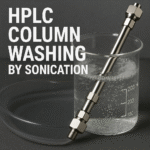HPLC Column Washing by Sonication is used to remove strongly adsorbed materials and improve column performance HPLC columns can be cleaned effectively using sonication, a process that uses ultrasound waves to help remove built-up contaminants. This method is especially helpful for getting rid of strongly adsorbed substances that regular flushing might miss. To clean the […]

HPLC Column Washing by Sonication is used to remove strongly adsorbed materials and improve column performance
HPLC columns can be cleaned effectively using sonication, a process that uses ultrasound waves to help remove built-up contaminants. This method is especially helpful for getting rid of strongly adsorbed substances that regular flushing might miss. To clean the column, it’s usually first flushed with suitable solvents to dissolve any residues, and then placed in an ultrasonic bath to loosen and remove remaining impurities. This can help restore performance and extend the column’s life.
The column plays a vital role in HPLC analysis, and it requires washing and maintenance. One of the most misunderstood—and sometimes controversial—maintenance steps is washing HPLC columns by sonication. Can it help? Should it be done? And if so, how?
In this post, we’ll explore what sonication does, when it’s appropriate for column cleaning, and how to do it safely.
What Is Sonication?
Sonication is the application of ultrasonic sound waves (typically 20–40 kHz) to agitate particles in a sample. In the context of HPLC, sonication is used primarily to:
It’s especially helpful for restoring flow or eliminating ghost peaks caused by contaminants.
This is where things get tricky.
YES, you can sonicate some columns under specific conditions—but with extreme caution.
NO, it is not universally recommended for all types of columns, especially high-end analytical columns with delicate bonded phases.
Always check the column datasheet or contact the manufacturer first.
Sonication may be helpful if:
If you’ve decided to proceed, here’s a safe method:
1. Remove the Column
2. Prepare a Cleaning Solvent
Use a compatible solvent such as:
Do not sonicate with highly basic or acidic solvents unless specified.
3. Place in a Beaker
4. Sonicate Gently
5. Flush After Sonication
Before you turn to sonication, try these steps:
HPLC column sonication is a useful but risky technique. It can revive a clogged or contaminated column—but should be used with full knowledge of the risks and manufacturer guidelines.
When used appropriately, sonication can extend the life of your column and improve chromatographic performance. But improper use may destroy valuable analytical tools in minutes.
When in doubt, consult the column manual—or your vendor’s technical support.
Related Topic
No. Not all columns are suitable for sonication. Many reversed-phase columns (like C18) may be damaged by ultrasonic waves. Always check the manufacturer’s guidelines before attempting sonication.
Use a solvent that is compatible with your column and target contaminants. Common choices include methanol, acetonitrile, or isopropanol. Avoid strong acids, bases, or unknown mixtures unless specified by the manufacturer.
Limit sonication to 5–15 minutes in a low-power ultrasonic bath. Prolonged or high-intensity sonication can damage the column’s packing material or bonded phase.
Further Reading
Quick Links